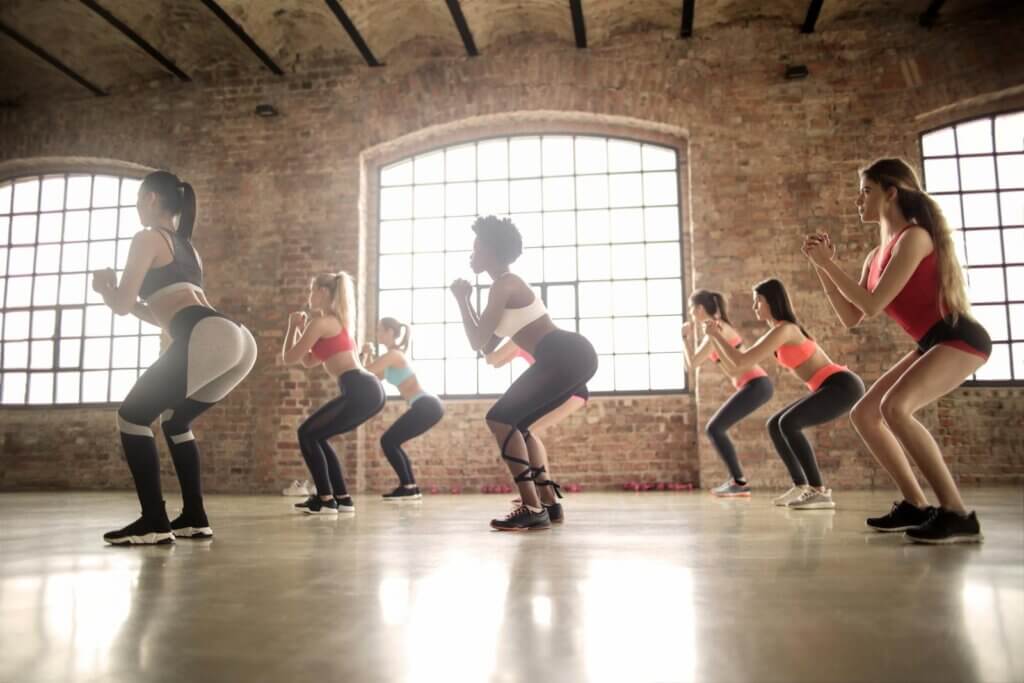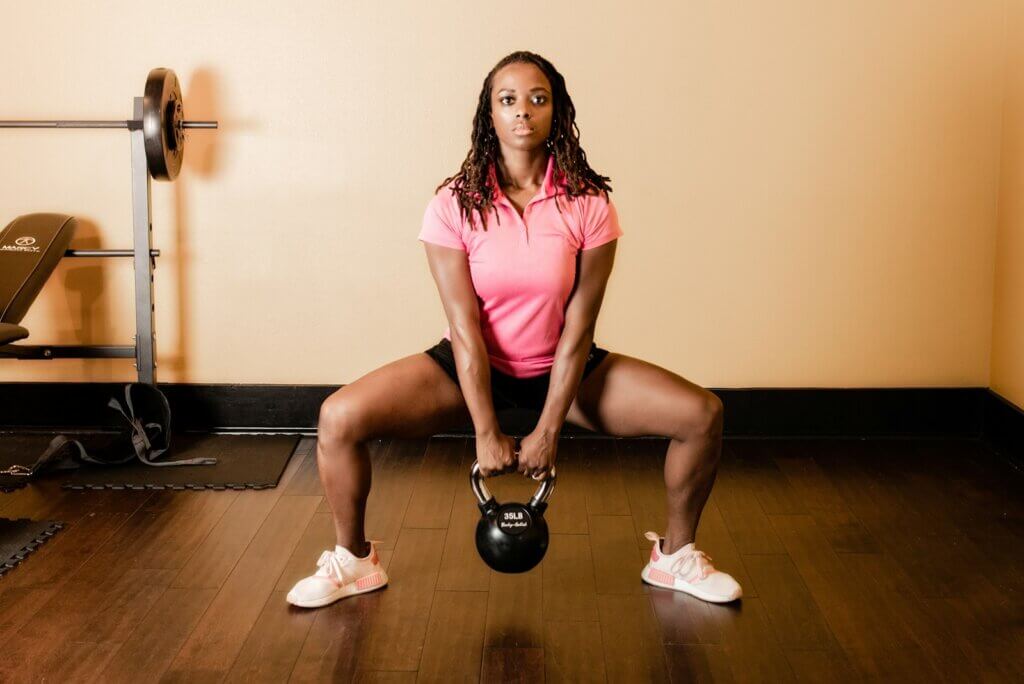How to Air Squat

Introduction:
The air squat, also known as the bodyweight squat, is a fundamental exercise in CrossFit and gym training. It’s a foundational movement that builds strength, flexibility, and endurance in the lower body while promoting proper movement mechanics. Whether you’re a beginner looking to refine your form or an intermediate athlete aiming to enhance your performance, mastering how to air squat is essential for anyone serious about their fitness journey.
Steps in the Air Squat movement
- Starting Position: Stand tall with your feet shoulder-width apart, toes slightly turned out. Keep your chest up, shoulders back, and core engaged.
- Descent: Initiate the movement by pushing your hips back and bending your knees. Lower your body down into a squat position, aiming to bring your thighs parallel to the ground. Keep your weight on your heels and maintain a neutral spine throughout.
- Bottom Position: At the bottom of the squat, your hips should be below your knees, and your chest should remain up. Ensure your knees are tracking in line with your toes, and your heels stay flat on the ground.
- Ascent: Drive through your heels to push yourself back up to the starting position. Keep your chest up and maintain control of the movement as you return to standing.
What Equipment is needed
- No equipment is necessary for the air squat. It can be performed anywhere, anytime, using only your body weight. Perfect for home gym training!
Check out the Equipment subsite for more tools, tips, and inspiration.

Shop Fitness gear now on Amazon
See Amazons extensive range of workout gear here. (Affiliate Link)
Scaling Options:
To gradually build strength and proficiency, consider the following scaling options:
- Use a support: Hold onto a stable surface, such as a railing or doorframe, to assist with balance and stability.
- Reduce range of motion: Perform partial squats by only lowering yourself partway down until you build the strength and flexibility to perform a full-depth squat.
- Elevate heels: Place a small weight plate or wedge under your heels to reduce ankle mobility requirements and make the squat easier.
Common Mistakes to Avoid:
- Collapsing Knees: Ensure your knees track in line with your toes throughout the movement. Avoid letting them cave inward, which can put stress on the knees.
- Round Back: Keep your chest up and your spine neutral throughout the squat. Avoid rounding your back, as this can lead to injury.
- Shifting Weight Forward: Keep your weight on your heels throughout the movement to maintain balance and stability. Avoid shifting your weight onto your toes, which can strain the knees and lower back.
Benefits of Air Squatting:
- Builds lower body strength: Targets muscles such as quadriceps, hamstrings, and glutes.
- Improves mobility: Enhances flexibility in the hips, knees, and ankles.
- Functional movement: Mimics everyday activities like sitting and standing, making it a practical exercise for improving overall fitness and quality of life.

Which Muscles Are Worked:
During this exercise, the following muscle groups are engaged:
- Primary Muscles: Quadriceps, glutes, hamstrings
- Secondary Muscles: Calves, lower back, core
Alternative Similar Movements:
If you’re seeking variation or targeting specific muscle groups, consider incorporating these alternative exercises:
Progressions to Enhance Air Squat Difficulty
Once you’ve mastered the basic air squat, progressing to more challenging variations can further develop strength and endurance. Incorporating equipment like resistance bands can add intensity to your squats. Loop a band just above your knees to engage the hip abductors, promoting proper knee alignment and increasing difficulty. Additionally, integrating tools such as squat machines can provide added resistance and support, allowing for a more controlled and intensified workout. For instance, machines like the Keiser A300 Squat offer adjustable resistance and support, enabling users to safely increase the load and target specific muscle groups more effectively. Utilizing such equipment can aid in building explosive power and enhancing overall lower body strength. Remember to focus on maintaining proper form and gradually increase resistance to prevent injury.

Shop Fitness gear now on Amazon
See Amazons extensive range of workout gear here. (Affiliate Link)
Warm-Up and Mobility Exercises
Before diving into air squats, it’s crucial to prepare your body adequately to prevent injuries and optimize performance. A proper warm-up increases blood flow to the muscles, enhances flexibility, and primes the nervous system for the workout ahead. Begin with 5-10 minutes of light cardiovascular activity, such as brisk walking or jumping jacks, to elevate your heart rate. Following this, incorporate dynamic stretches focusing on the lower body. Leg swings, hip circles, and lunges with a twist can effectively loosen up the hip flexors, hamstrings, and quadriceps. Additionally, ankle mobility drills, like calf raises and ankle circles, can improve range of motion, aiding in achieving proper squat depth. Spending time on these preparatory exercises not only enhances performance but also reduces the risk of strains and sprains during your squatting routine.
Incorporating Air Squats into Your Workout Routine
Air squats are versatile and can be seamlessly integrated into various workout regimens. For strength training, consider adding them as a warm-up exercise to activate the lower body muscles. In high-intensity interval training (HIIT), air squats can serve as a cardio-intensive movement, elevating heart rate and promoting fat burn. For endurance building, perform higher repetitions with shorter rest periods. Alternatively, include air squats in circuit training routines, pairing them with upper body exercises to create a balanced full-body workout. Tailoring the volume and intensity of air squats to align with your fitness goals ensures that you maximize their benefits within your exercise program.
Breathing Techniques During Air Squats
Proper breathing is often overlooked but plays a vital role in executing air squats efficiently. Coordinating your breath with your movements can enhance stability and power. As you initiate the descent into the squat, inhale deeply through your nose, filling your diaphragm. This inhalation braces your core, providing spinal support. Upon ascending, exhale steadily through your mouth, releasing the breath as you return to the standing position. This breathing pattern not only supports core stability but also ensures a steady oxygen supply to your muscles, delaying fatigue. Practicing mindful breathing can lead to more controlled and effective squatting sessions, contributing to overall workout efficiency.
Monitoring Progress and Setting Goals
Tracking your progress with air squats is essential for continuous improvement and motivation. Begin by establishing a baseline: note the number of repetitions you can perform with proper form before fatigue sets in. Set specific, measurable goals, such as increasing your rep count by a certain number each week or achieving a deeper squat depth. Utilize tools like fitness journals or mobile apps to record your performance and monitor improvements over time. Regularly reassessing your goals and acknowledging milestones not only keeps you motivated but also provides tangible evidence of your advancing strength and endurance. Remember, progress may be gradual, but consistent effort leads to significant long-term gains.
Q&A for Air Squats
How to do air squats for beginners?
Beginners should start with mastering the basic form: keep chest up, knees tracking toes, and weight on heels. Gradually increase depth and resistance as strength improves.
Do air squats really work?
Yes, air squats effectively strengthen leg muscles and improve overall lower body endurance when performed correctly and consistently.
How long do you hold an air squat?
Air squats are typically performed with a controlled descent and ascent. Holding the bottom position briefly helps maintain muscle tension and control.
Is 100 air squats a day good?
Doing 100 air squats a day can be a good workout for muscular endurance and general fitness. It’s important to vary intensity and incorporate rest days.
Will 30 squats a day make a difference?
Yes, consistently performing 30 squats a day can improve lower body strength and endurance over time. Progress gradually and ensure proper form.
Is a 1.5 bodyweight squat good?
A 1.5 bodyweight squat is considered strong and indicates good lower body strength. Adjust intensity based on individual fitness goals and capabilities.
What happens if I do 500 squats a day?
Doing 500 squats a day can lead to significant muscle fatigue and soreness, potentially causing overuse injuries. It’s crucial to listen to your body and vary workouts for recovery.
What will happen if I do 100 squats a day for 30 days?
Performing 100 squats a day for 30 days can improve lower body strength, endurance, and muscle tone. Combine with proper nutrition and rest for optimal results.
Will 50 pushups a day do anything?
Yes, doing 50 pushups a day can improve upper body strength and endurance. Incorporate variations and increase reps as strength progresses.
Is squatting 10kg good?
Squatting 10kg can be a good starting point for beginners. Gradually increase weight and focus on proper form to avoid injury and maximize muscle development.
Conclusion:
Mastering the air squat is not just about building strength; it’s about developing proper movement patterns and functional fitness that will serve you well in all areas of your life. So, embrace the challenge, focus on form, and let this guide on how to do an air squat become a cornerstone of your fitness journey.

Shop Fitness gear now on Amazon
See Amazons extensive range of workout gear here. (Affiliate Link)

🏋️ Written by: Mike Kerr
Mike is the founder of Strengthguides.com and a certified CrossFit Level 1 Trainer (CF-L1) and certified Kettlebell Instructor with over 10 years of experience in functional fitness. He specializes in developing programs that maximize performance without sacrificing mobility. Mike Kerr is passionate about making complex training methodologies comprehensible and safe for everyone.
